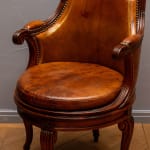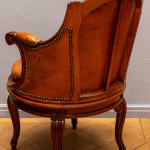attributed to Georges Jacob
Further images
A very fine Louis XVI carved rosewood rotating fauteuil de bureau with brown leather upholstery attributed to Georges Jacob, with a close-nailed tan coloured leather padded back and arm rests and a circular padded seat-cushion above a caned seat, the channelled frame with an arched top rail and down swept arms with a swivel seat above a moulded seat rail, on scrolled legs and toupie feet headed by rosette paterae
Paris, date circa 1780
Height 89 cm, width 55 cm, height of seat 47cm.
Literature: Carle Dreyfus, “The Louvre Museum, French Furniture. Louis XVI Period”, 1921, p. 40, illustrating a very similarly shaped carved giltwood fauteuil de bureau made by Georges Jacob for Queen Marie-Antoinette, now in the Musée du Louvre, Paris, which has similarly shaped legs and arms but has a straight top rail and is caned overall, rather upholstered in leather. Pierre Kjellberg, “Le Mobilier Français de la Transition Louis XV-Louis XVI à 1925”, 1980, p. 46, illustrating a near identical rotating fauteuil de bureau, which is unstamped and attributed to Georges Jacob; it lacks its padded cushion to expose the caned seat below. Pierre Kjellberg, “Le Mobilier Français du XVIIIe Siècle”, 1989, p. 422, illustrating an extremely similar fauteuil de bureau by Georges Jacob as well as two others by the same maker, one upholstered in leather and with the same legs and channelled seat rail but with a circular rather than shaped top rail, the other with caning to back, sides and seat, with leather padded arm rails but with a curved back rail and straight fluted legs.
This elegant rotating desk chair, which is made of rosewood and thus rare, is closely related to a fauteuil de toilette made in about 1770 by the esteemed menuisieur Georges Jacob (1739-1814) probably for the comtesse du Barry at the Petit Trianon, which also bears the brand of Marie-Antoinette’s Garde-Meuble (inv.OA6553). In addition to the very closely related chair made by Jacob for Marie-Antoinette, now in the Musée du Louvre (Dreyfus, op. cit) as well as those illustrated in Kjellberg’s two books (cited above), several closely-related examples have been offered for sale including one from Godmersham Park, near Canterbury, Kent (sold by Christie’s, 6-9 June 1983, lot 192), another offered by Couturier-Nicolay, Paris, 20th October 1983, lot 65 as well as an extremely closely related fauteuil sold by Christie’s London, 19th May 2021, lot 28.
Given the close similarity between this handsome chair and others bearing Georges Jacob’s stamp or merely those that are unstamped and are thus attributed, one can safely say that this example should also be attributed to the same master. Together with Jean-Baptiste-Claude Sené (1748-1803), Jacob dominated the production of carved furniture and menuiserie in Paris during the last years of the ancien régime. Their principal clients were Louis XVI and his wife Marie Antoinette for whom they provided an array of carved seats, stools, consoles, beds and screens for their residences at Fontainebleau, the Tuileries, Versailles and Saint-Cloud. As an ingenious maker, Jacob often hollowed out the inside of the seat-rails of his chairs in order to make them lighter while maintaining their strength and stability. His skill in making carved wood furniture was outstanding while his artistic inventiveness enabled him to produce a very wide range of chair designs without repetition. As such his oeuvre is represented among the world’s finest collections. More important pieces can be seen in the Wallace Collection and Victoria and Albert Museum in London, at Windsor Castle, the Musée du Louvre and Musée des Arts Décoratifs in Paris; Châteaux de Versailles and Fontainebleau as well as the Musée Condé, Chantilly. His repute, which has continued to this day, was perfectly summarized in the words of the eminent historian Count de Salverte, who wrote “He dominated his rivals by the perfection of his technique and his amazing creativity, giving even his most modest works a peculiar element of nobleness and grace.”
Georges Jacob was born at Cheny, near Tonnerre in Burgundy, on 6th June 1739. At about the age of sixteen he went to Paris where he served a three-year apprenticeship under Louis Delanois (1731-92) before being received as a maître in September 1765. It was not long before he established repute and from 1773 began to receive numerous commissions from the Crown. In 1781 he was appointed ébéniste-ordinaire to Monsieur le comte de Provence (later Louis XVIII) and from 1784 became one of the Fournisseurs des Menus-Plaisirs. He was also among the small number of non-Germanic cabinet-makers to be favoured by Queen Marie Antoinette. Although chiefly renowned for his chairs, he made many other types of furniture; his work even extended to the restoration and replacement of Boulle medal-cabinets at Château de Saint-Cloud. During the 1780s, he was particularly influenced by English furniture makers and as such introduced into France the lyre back chair. He was also one of the first French furniture makers to take advantage of good quality woods such as mahogany for making carved chairs and then, instead of gilding, he ornamented some pieces with high quality gilt bronze mounts. Shortly before the French Revolution, he executed a suite of mahogany furniture in the austere classical style for the studio of the Neo-classical painter, Jacques Louis David (1748-1825). Such pieces were among immediate sources from which the style of furniture adopted under the Directory, the Empire and the Restoration, was subsequently derived.
In 1788 Jacob was made syndic-adjoint of his guild and would have been appointed syndic the following year had it not been for the outbreak of the Revolution. By 1789 he was in a firmly established and brilliant social position with a large house in the rue Meslée but soon after he suffered heavy losses with the emigration of his principal clients; among others the king’s brother, left an outstanding debt of 85,000 livres. Jacob had been too closely associated with the royal family to please the revolutionaries and was thus placed under suspicion. To demonstrate his patriotism, he began making gunstocks for the republican army. But even this and his friendship with Jacques Louis David (who obtained for him a commission to provide the chairs used by the Convention when sitting in the Palais des Tuileries) did not prevent him from being twice denounced. He however survived the Revolution and shortly after, during the reign of Napoleon, his firm once more assumed prominence. Jacob had founded an important dynasty of furniture makers. From 1765 he worked under his own name but in 1796 he retired and handed over the business to his two sons, Georges II (1768-1803) and François-Honoré-Georges (1770-1841). They continued it under the name of Jacob Frères until the premature death of the elder son in 1803. The younger, who took the name of Jacob-Desmalter, then joined with his father working under the name of Jacob-Desmalter et Cie –a business that was to strongly patronised by Emperor Napoleon Bonaparte. Despite phenomenal repute, Jacob-Desmalter, like many in the luxury trade, suffered severely from the industrial crisis following the Peninsular War and Russian campaign. In 1813 Georges I Jacob retired, coinciding with the firm declaring bankruptcy. This however was short lived as business revived rapidly after the restoration of Louis XVIII in 1814 and continued up until 1847 when it was sold to Charles-Joseph-Marie Jeanselme.





